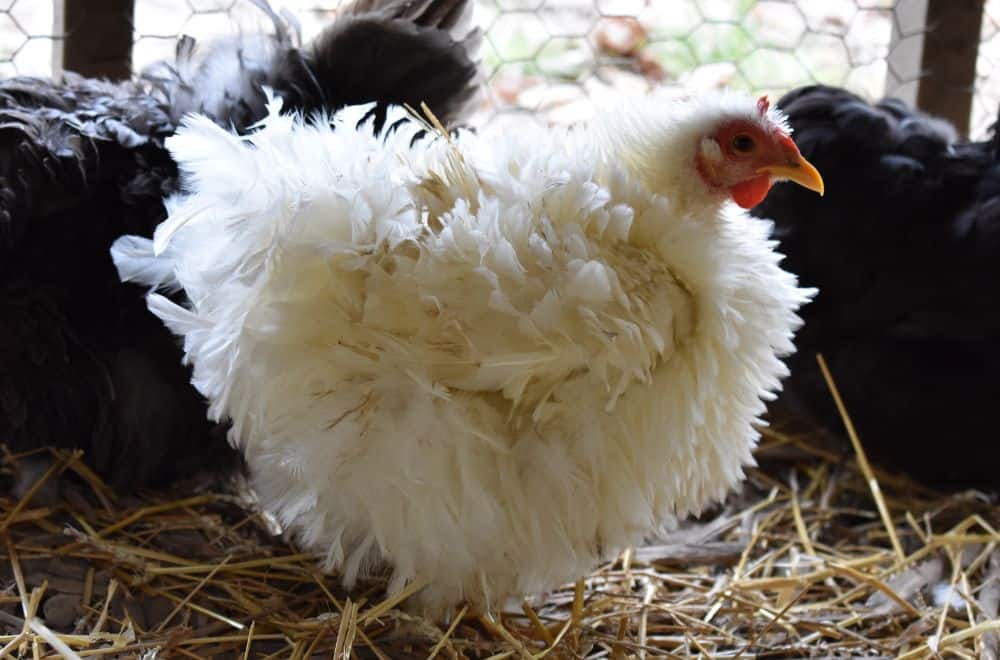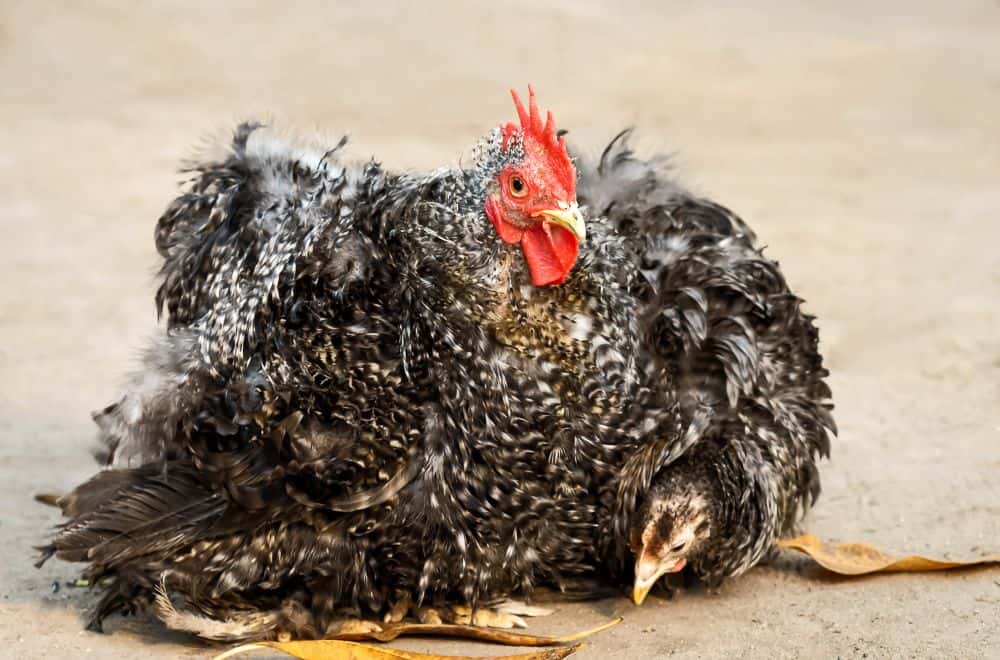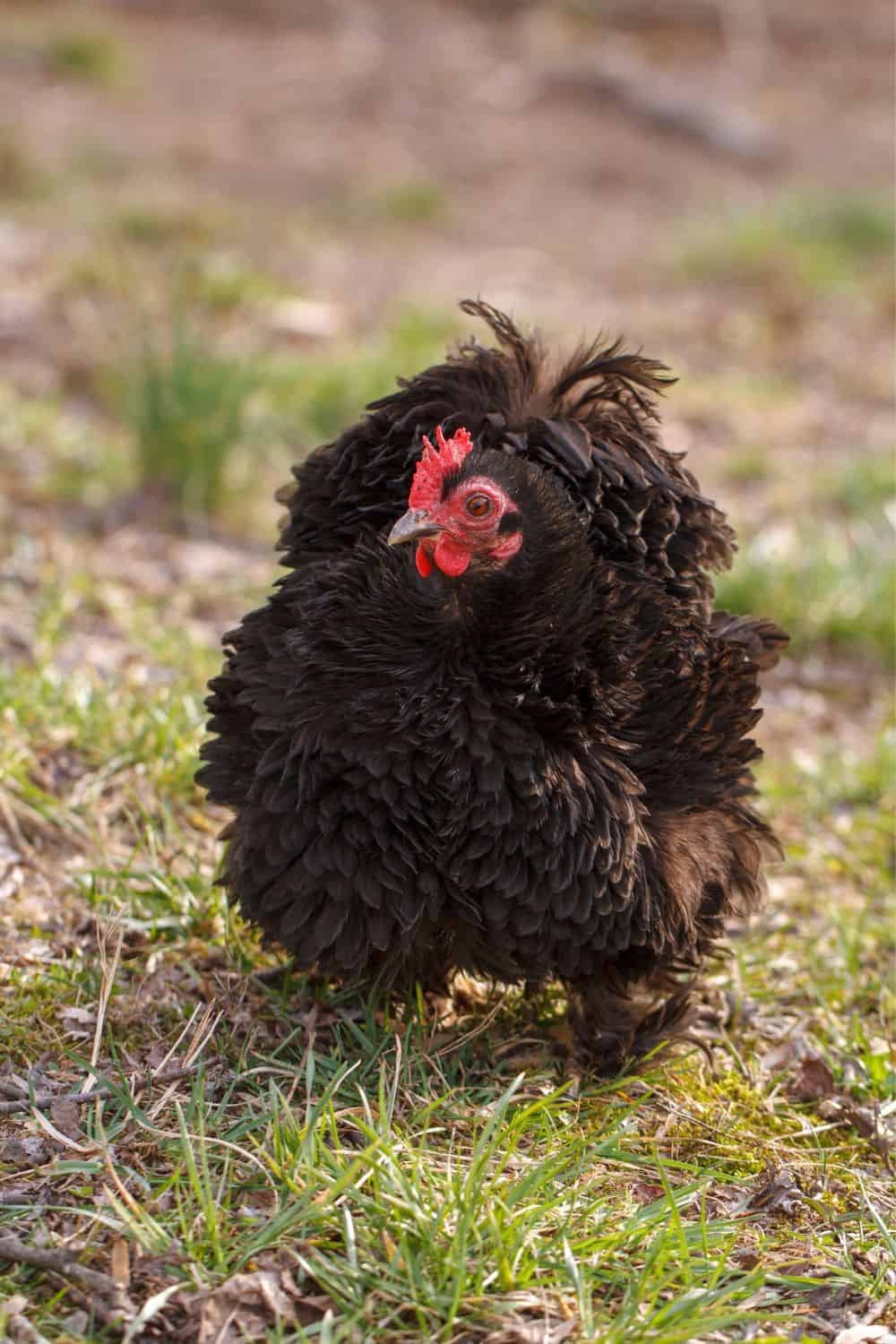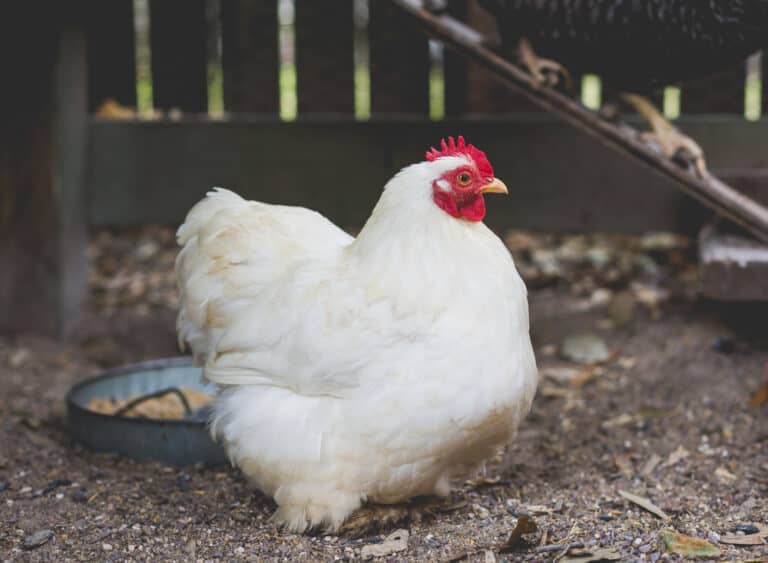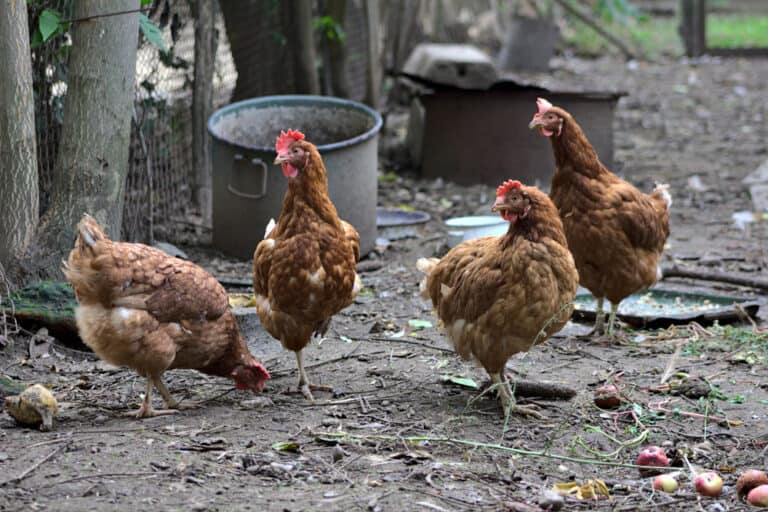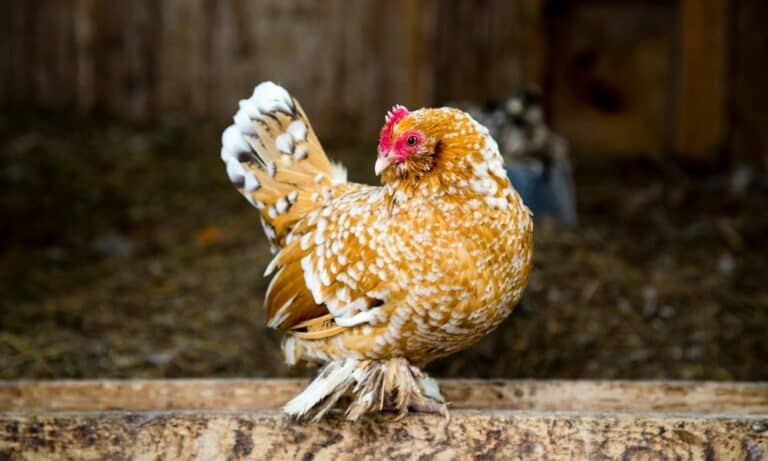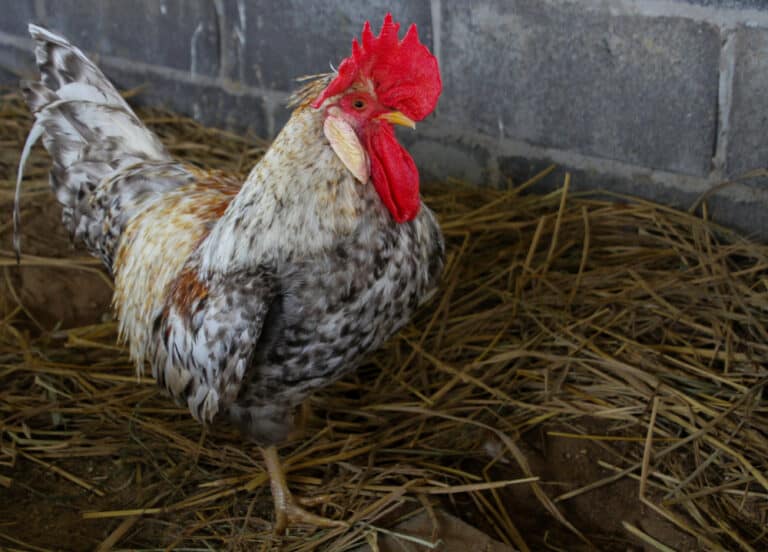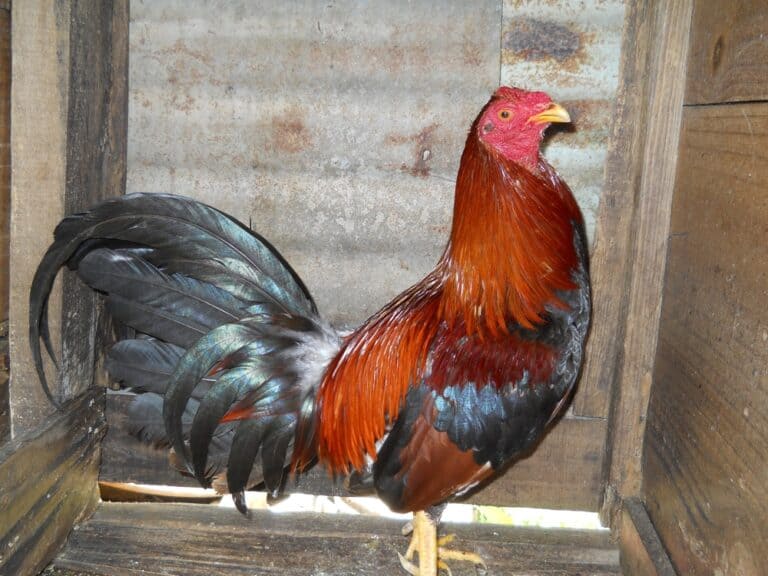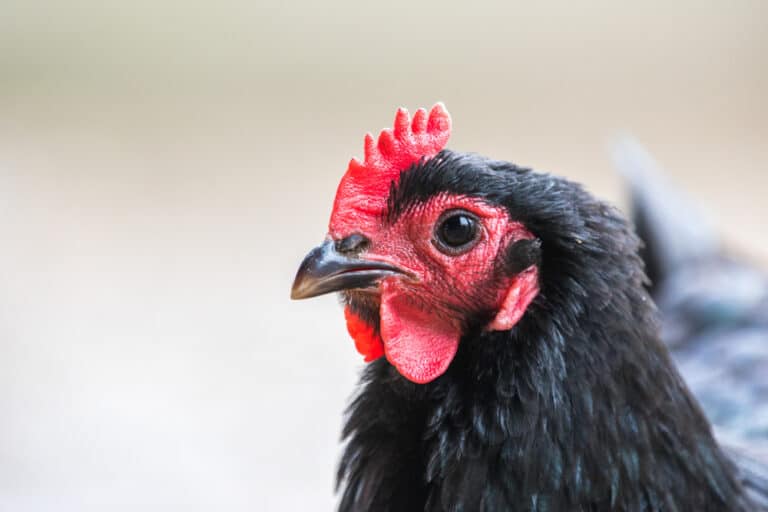Frizzle chickens are a lovely, fun-looking Asian breed with curly feathers you can keep as pets or for egg production. Only several countries recognize this unique chicken as a separate breed, but the US is not one of them.
Since you can find numerous variations and colors, they are technically not a special breed but a result of an incomplete dominant gene. Experts consider them only a feather variation of existing breeds, like Japanese Bantams, Cochins, Barred Rocks, and Polish.
Frizzle chickens |
|
| Origin | Asia (unrecognized in the US) |
| Breed size | Small |
| Broodiness | yes |
| Rarity | Quite rare |
| Climate tolerance | All climates |
| Care level | Easy |
| Lifespan | 6 to 8 years on average (3 to 10 years) |
| Standard weight | Cock – 7 to 9 pounds (3 – 4 kg) Hen – 5 to 6 pounds (2.3 – 2.7 kg) |
| Bantam weight | Cock – 1.65 pounds (0.75 kg)Hen – 1.1 pounds (0.5 kg) |
| Feather color | Curly feathers in a few color variations, including favorite buff and brown |
| Comb type | Red and single |
| Leg color | Yellow |
| Leg type | Clean |
| Purpose | Eggs, pets, exhibitions |
| Egg size | Medium |
| Egg color | White, cream, or tinted |
| Annual egg production | 120 to 150 eggs |
| Sitter | Occasionally |
| Flying ability | Unable to fly |
| Temperament | Docile, cuddly, friendly, and calm |
| Beginner friendly | yes |
| Start of egg production | 5 to 6 months |
Frizzle History
Since Aldrovandus described Frizzle chickens in the 1600s, you can guess that this poultry has existed for a long. It is confirmed that they were bred in England in 1676, but experts were unsure about their origin.
They probably came from the Far East but also existed in China and East India. Almost three centuries after that, in the 1930s, Hutt determined the cause of a specific feather curling.
He found an incomplete dominant gene affecting this trait and modifying factors controlling its impact. However, no one knew what breeds were a base for those chickens, so scientists assumed they appeared as an accidental keratin gene mutation.
Nowadays, Frizzle chickens are recognized as a breed in the following countries:
- The UK, Ireland, and Australia
- The Czech Republic, Poland, Slovakia
- Germany, Belgium, France, Italy
In the US, the term frizzles refer only to a plumage type, and you can exhibit your chickens in shows as breed specimens. For instance, they are often recognized under the categories like Frizzled Pekin and Frizzled Polish.
What is Frizzling?
Frizzling is a chicken trait that implies curling feathers outward from the body and upward, resulting in a unique appearance. Some breeds inherit it through an incomplete dominant gene.
You will get the frizzling effect only when at least one parent carries this gene. However, the bird, the so-called Frazzle chicken, will be particularly frizzly because both parents are carriers. You can recognize four curly-feathered chicken types:
Frazzle chickens – This type is rare and has two frizzling genes.
Frizzles – These chickens, particularly bantams, have the curled feather gene regardless of the breed.
Sizzles – These chickens come with combined frizzle and silkie feathers because they are offspring of Silkie hens and frizzled roosters.
Flat chickens – This type may carry the frizzle gene, although it looks like standard flat-feathered poultry.
Curly chickens |
|
| Parents | Chicks |
| Frizzle x Frizzle | 25% frazzle; 25% flat; 50% frizzle |
| Frizzle x Flat | 50% frizzle; 50% flat |
Most breeders avoid producing Frazzle chickens because they are prone to numerous health issues, such as an enlarged heart. They are also sensitive to low temperatures, and hens are poor egg layers.
Besides, they always have a shorter lifespan and poor-quality feathers and may become totally bald over time. That results in sunburns during the summer and frostbite in winter.
Therefore, you can find only crossbreed frizzles with one smooth-feathered parent. Knowing the bloodline is crucial since knowing which feather type chicks have before it appears is impossible.
Frizzle Chicken Traits
Be prepared that Frizzle chickens are demanding despite their calm and friendly nature. Putting them with other poultry will probably result in hurt birds with plucked feathers since they can’t defend themselves.
General characteristics
You can differentiate roosters from hens only after 4 to 8 weeks of their lives. Since cocks start crowing from 1 to 16 weeks, you can be sure of what you have thanks to this indicator.
Besides, males typically grow faster, quickly get longer tail feathers, and their combs are redder. Since Frizzle roosters sometimes become aggressive, many owners prefer keeping friendly, cuddly, and easy-to-handle hens. Plus, they lay eggs, making them beneficial.
It is impossible to detect whether chicks have frizzling genes in the first 14 days of their lives. Therefore, you should be careful with Frizzle chickens and purchase them only from reputable breeders. Be prepared that they are rare, and finding them on the market can be challenging.
Appearance
Unlike some European countries where Frizzle chickens are classified as a separate breed, this term implies only a feather type in the US. Therefore, it is impossible for these birds to be judged as the Frizzle breed, but only according to their compatibility with the standard.
The most typical characteristic is these chickens’ plumage. These birds look like a bunch of windswept and unmanageable wild feathers attached to two yellow legs. Whether you have a frizzle or flat breed, they will have moderately long and soft feathers instead of spiky ones.
These chickens typically have strong, short, yellow beaks, wattles, single upright combs, red earlobes, and bright red eyes. Their breasts are full, while erect bodies are broad with long wings and imposing tails. Finally, you can see clean yellow legs with four toes at each foot.
Weight
Standard Frizzle chickens are about 5 to 9 pounds (2.3 – 4 kg) heavy. Hens are smaller, with 5 to 6 pounds (2.3 – 2.7 kg), while roosters often reach 7 to 9 pounds (3 – 4 kg).
The Bantam variety is tiny, and cocks weigh only 1.65 pounds (0.75 kg). Hens hardly reach a weight of 1.1 pounds (0.5 kg).
Color
All Frizzle chickens have thin curly feathers, but their coloration depends on the breed type you have. Frizzle chickens are officially recognized in numerous colors. However, breeders tirelessly experiment with new shades, so you can probably find a few other combinations. For now, the most popular are:
Behavior
Besides looking adorable, Frizzles are well-tempered, friendly, and sweet. These docile chickens are soft-spoken and an excellent option for families with toddlers. People often keep these shy and gentle creatures as pets, house birds, and lap chickens.
Since they may have problems with other poultry, particularly aggressive breeds, you should keep them only with docile and friendly chickens. Their best companions are Silkies, Cochins, Sultans, and Polish chickens.
Purpose
Most people keep Frizzle chickens as pets or for shows. They are beautiful but without the exceptional ability to lay eggs. You can expect hens to start laying cream eggs at 5 or 6 months of age and reach an annual production of 120 to 150 eggs.
However, the final egg number depends on the variety. For instance, Cochin Frizzle chickens lay 2 to 3 eggs weekly, while Rock Frizzles produce 3 to 4 eggs in the same period.
This breed is too small to produce enough meat, but some heavy breeds can provide a decent meal if you don’t have an excellent appetite. Since hens are excellent brooders, you can breed your own chicks. Unfortunately, they are too trusting and can’t protect their offspring from predators.
Health and Care
Frizzles are a backyard breed that needs an area for free roaming but can also handle confinement when necessary. Each chicken should get about 16 sq ft (1.5 m2) of predator-proof run space.
Besides, you should provide at least 4 sq ft (0.37) per chicken to spend the night indoors. However, they need at least 10 sq ft (1 m2) when you plan to keep them inside during the day. Since they can’t fly, always place nesting boxes and perches close to the ground.
Each chicken needs approximately 0.25 pounds (115 g) of feed daily. They require 16% of protein, but this percentage should be 18% to 20% during the molt period. Remember that hens need additional calcium when keeping them indoors.
Frizzle chickens are a naturally healthy breed. However, you can notice a few crucial problems, including:
- Their head feathering is too dense and may impair their eyes and endanger their vision
- Inability to avoid danger by flying away
- Low cold tolerance
- The impossibility of their thin curly feather keeping them dry during the rain
Besides these inconveniences, Frizzle chickens are typically healthy poultry. You should prevent internal and external parasite invasion and check them regularly for possible infestation.
Keep your birds dry and warm, and never allow them to stay soaked after heavy rain. Otherwise, they may end up with hypothermia and probably die from the cold.
Summary
Frizzle chickens are beautiful, unusual, and friendly creatures incredibly easy to handle. It is an old Asian breed mentioned in the 1600s. Besides being docile pets and your kid’s best friends, these lovely birds lay approximately two to four eggs weekly.


